Painters have always loved painting angels. Thanks to their little wings, they can be placed anywhere in the picture, and can be as many as the the narrated event needs. They can carry hidden symbolic message and because of it they can bring more information about sitters or about the depicted event.
In heaven they play a host of musical instruments, they sing, they dance, they recite, and they can be messengers sent by God to the man with good or sometimes bad news. They can be sent to inform Virgin Mary that she is expecting a child who shall be Christ, and to inform shepherds and Maggi when the birth is due. They can also be a warriors of the celestial armies sent by God to fight fallen angels, demons, and devils in heaven and on the earth as well.
For early Christian painters the problem finding a visual representation of such immaterial spirit as angel was solved by adapting the pagan winged figures of Victory and Nike although the most earliest Christian paintings or mosaics from second and third centuries shows them as wingless young men in white long robes. Many times happens that wingless angels were confusing with humans. By 350 AC winged figures of angels became common and universal by 600 AC. Around a century later the nimbus or aureole was added to better distinguish them from ordinary people. Because of their function to worship and sing glory of God they appear in the European paintings mostly as:
- Love Triumphant
- Musicians of the Soul
- Divine Messengers
- The Celestial Armies
- Guardian or Accompanying Angel
1. Love Triumphant
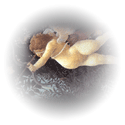 From the earliest times painters admired this little winged, always smiled, and chubby
aeronauts. They called them Cherub, Putto, Eros, Amor or Cupid, depends on the role
they played in the picture. In the most ancient cosmogonies, this little aeronaut was
considered to be the god of creation, born of primitive chaos and one of the primordial
elements of this world. The Greeks called him Eros - divinity of love and lust. Eros remained the god of love through the
centuries until our time.
From 6th century BC onwards he presided over marriages and victories, over love and lust,
and over jealousy and sin. In Hellenistic times artists and poets transformed
the dengerous god into an innocent looking, sweet, winged baby (Cupid) and
give him a bow and arrows, a toy looking but very dangerous wappon to play with.
From the earliest times painters admired this little winged, always smiled, and chubby
aeronauts. They called them Cherub, Putto, Eros, Amor or Cupid, depends on the role
they played in the picture. In the most ancient cosmogonies, this little aeronaut was
considered to be the god of creation, born of primitive chaos and one of the primordial
elements of this world. The Greeks called him Eros - divinity of love and lust. Eros remained the god of love through the
centuries until our time.
From 6th century BC onwards he presided over marriages and victories, over love and lust,
and over jealousy and sin. In Hellenistic times artists and poets transformed
the dengerous god into an innocent looking, sweet, winged baby (Cupid) and
give him a bow and arrows, a toy looking but very dangerous wappon to play with.
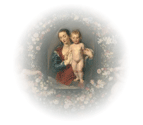 The Renaissance took over the Hellenistic approach of the theme. To emphasize the power
of love of this unpredictable god a little band was added to cover his eyes (Botticellli).
Little winged love triumphant was inspiration for the poets and painters. They showed
him as a smiling chubby boy, who by the shooting his arrows in the human hearts
painfully wounding and enflaming them. For Romans he was Amor or Cupid, a chubby boy retained the
child's form bestowed on him by Praxiteles.
Artists of all times showed him on many masterpieces as a little childlike angel,
little putto, sometimes singly but often in the galaxies of
playful children upholding a garlands of flowers, or as a chain of little putti rising
Virgin Mary or Jesus to Heaven, or even holdiing a table with important love insctiption.
In the history of European art there is no painter who never painted this little
winged, sweet areonaut.
The Renaissance took over the Hellenistic approach of the theme. To emphasize the power
of love of this unpredictable god a little band was added to cover his eyes (Botticellli).
Little winged love triumphant was inspiration for the poets and painters. They showed
him as a smiling chubby boy, who by the shooting his arrows in the human hearts
painfully wounding and enflaming them. For Romans he was Amor or Cupid, a chubby boy retained the
child's form bestowed on him by Praxiteles.
Artists of all times showed him on many masterpieces as a little childlike angel,
little putto, sometimes singly but often in the galaxies of
playful children upholding a garlands of flowers, or as a chain of little putti rising
Virgin Mary or Jesus to Heaven, or even holdiing a table with important love insctiption.
In the history of European art there is no painter who never painted this little
winged, sweet areonaut.
2. Musicians of Soul
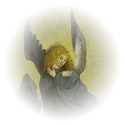 When the Christian era became in the middle of the IV century, the little winged
aeronauts, angels, were lavished with higher intelligence superior to the human soul
and the function they hold in the celestial court was also given to them.
(More about their function and symbolism: Angel as a Symbol in European Art).
The Church taught that angels were created by God before man to bliss and grace Him, to serve Him, to worship Him
and to sing His glory.
When the Christian era became in the middle of the IV century, the little winged
aeronauts, angels, were lavished with higher intelligence superior to the human soul
and the function they hold in the celestial court was also given to them.
(More about their function and symbolism: Angel as a Symbol in European Art).
The Church taught that angels were created by God before man to bliss and grace Him, to serve Him, to worship Him
and to sing His glory.
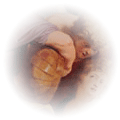 Cherubim, originally guardians of doors, were promoted by Medieval Church to
the ranks of
singing and playing instruments angels. Seraphim, winged serpents of fire, changed
candle into trumpets
and become partly heralds of God and partly musicians.
Cherubim, originally guardians of doors, were promoted by Medieval Church to
the ranks of
singing and playing instruments angels. Seraphim, winged serpents of fire, changed
candle into trumpets
and become partly heralds of God and partly musicians.
3. Divine Messengers
From the 4 th century, when the concept of angel was accepted by in the Church, some doctors of the Church and some pops were a little suspicious of angels, despite the fact that some of them were named in the Bible: Gabriel, Michael and Raphael on the side of God, and Satan, Beelzebub, Lucifer and others on the side of evil. The suspicious of the Church revived again in the Renaissance time when the border between angels and winged figures of Classical Antiquity became more and more narrower. They did not want anybody to be confused by Cherubim and Seraphim with Amor, Cupid or Eros. In the Early Renaissance some directive were made where Church suggested that the messenger of the good news Gabriel should be depicted as an Angel with the soft girl's face dressed in the white, gold or red richly silver and gold ornamented robe with big white or light-blue wings, holding white lily flower or white rose in his hand. This not changed canon survived till our times.
4. Celestial Armies
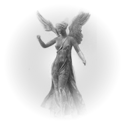 It was Hebrews, who made a connection between the winged ancient statue and their own
angels descbed and named in Bible as
Gabriel, Raphael, and Michael or Satan, Beelzebub and Lucifer.
And it is also Bible,
where a battle between Michael and fallen angels is related in details. This biblical
subject played very important role in Europenan art and was very often undertaken by
painters in more than 2000 years history of European art. Of course,
a distinction between the good warrior
angel with the bad or fallen angel had to be created.
Church took care of it. Church representatives suggested to depict a good warrior
angel as a tall, good-looking young man in black, glistening armor riding on white horse,
keeping a spear or a sword in his hand from the God side and
winged monster, dragon, serpent or demon from the evil side.
It was Hebrews, who made a connection between the winged ancient statue and their own
angels descbed and named in Bible as
Gabriel, Raphael, and Michael or Satan, Beelzebub and Lucifer.
And it is also Bible,
where a battle between Michael and fallen angels is related in details. This biblical
subject played very important role in Europenan art and was very often undertaken by
painters in more than 2000 years history of European art. Of course,
a distinction between the good warrior
angel with the bad or fallen angel had to be created.
Church took care of it. Church representatives suggested to depict a good warrior
angel as a tall, good-looking young man in black, glistening armor riding on white horse,
keeping a spear or a sword in his hand from the God side and
winged monster, dragon, serpent or demon from the evil side.
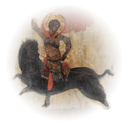 This cannon has many centuries tradition but sometimes the deviation from the principle
was made and the celestial warrior is riding a black horse instead as can be seen
on the outstanding 14th century masterpiece of Russian icon in British Museum of London.
The history of this icon is very unusual. This extraordinary icon was found in 1959
in the tiny village of Pskov by the wife of the former dissident Russian author.
For years this panel was being used as the shutter of a barn window. Subsequent
cleaning by conservators revealed that it had been overpainted several times. Below an
eighteenth-century folk painting they uncovered a seventeenth-century layer and finally this outstanding
fourteenth-century icon, which was immediately recognized as an early masterpiece of Russian painting.
In the time of discovery the icon was incorrectly recognized as "St. Michael fighting serpent";
while the lack of wings would suggests that the warrier is St. George instead. Conservations in late 70's
revealed an inscription in the upper right hand corner in Cyrillic script which correctly identifies the saint.
He is shown with a halo, and a red cloak billowing behind. The saint George is painted in vigorous motion,
reining in his leaping horse. The representation of the saint on a black,
rather than white horse is extremely rare and gave the icon's popular name, "The Black George".
This cannon has many centuries tradition but sometimes the deviation from the principle
was made and the celestial warrior is riding a black horse instead as can be seen
on the outstanding 14th century masterpiece of Russian icon in British Museum of London.
The history of this icon is very unusual. This extraordinary icon was found in 1959
in the tiny village of Pskov by the wife of the former dissident Russian author.
For years this panel was being used as the shutter of a barn window. Subsequent
cleaning by conservators revealed that it had been overpainted several times. Below an
eighteenth-century folk painting they uncovered a seventeenth-century layer and finally this outstanding
fourteenth-century icon, which was immediately recognized as an early masterpiece of Russian painting.
In the time of discovery the icon was incorrectly recognized as "St. Michael fighting serpent";
while the lack of wings would suggests that the warrier is St. George instead. Conservations in late 70's
revealed an inscription in the upper right hand corner in Cyrillic script which correctly identifies the saint.
He is shown with a halo, and a red cloak billowing behind. The saint George is painted in vigorous motion,
reining in his leaping horse. The representation of the saint on a black,
rather than white horse is extremely rare and gave the icon's popular name, "The Black George".
5. Guardian or accompanying angel
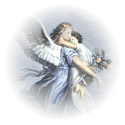 The concept of guardian or accompanying angel became very popular especially in 16th/17th centuries
and was made an universal by
Clement X in 1670. The suggested by the Church representation of the guardian/accompanying angel was similar to
the one depicted by G. A. Guardi in the church dedicated to the Angelo Raffaele in Venice.
Representation of the guardian or accompanying agnel as an angel carrying the human' soul
(depicted as a human body) became stanandard and was adopted by Guercino
(Fano, Sant'Agostino) and his followers from XVIII and XIX century.
The noble naturalism of XIX century
gave way to more regular and pagan style of angel's beauty. In angels throw off
their wings and adsorbed more advisory and consultative role. In the modern art the resemblence of the angel and
needed help person is so big that is imposible to distinguish, but this problem artists left to our imagination and understanding.
The concept of guardian or accompanying angel became very popular especially in 16th/17th centuries
and was made an universal by
Clement X in 1670. The suggested by the Church representation of the guardian/accompanying angel was similar to
the one depicted by G. A. Guardi in the church dedicated to the Angelo Raffaele in Venice.
Representation of the guardian or accompanying agnel as an angel carrying the human' soul
(depicted as a human body) became stanandard and was adopted by Guercino
(Fano, Sant'Agostino) and his followers from XVIII and XIX century.
The noble naturalism of XIX century
gave way to more regular and pagan style of angel's beauty. In angels throw off
their wings and adsorbed more advisory and consultative role. In the modern art the resemblence of the angel and
needed help person is so big that is imposible to distinguish, but this problem artists left to our imagination and understanding.
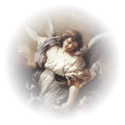 The beautiful winged individuals were the most favorite objects to the Renesaince painters.
The picturesque and graceful winged angels flying around Madonna or mitological beauty,
singing Cherubim, playing misical instruments Serapim, Eros with his dangerous arrows
or filling awkward space putti made the picture vivid and desirable.
The beautiful winged individuals were the most favorite objects to the Renesaince painters.
The picturesque and graceful winged angels flying around Madonna or mitological beauty,
singing Cherubim, playing misical instruments Serapim, Eros with his dangerous arrows
or filling awkward space putti made the picture vivid and desirable.